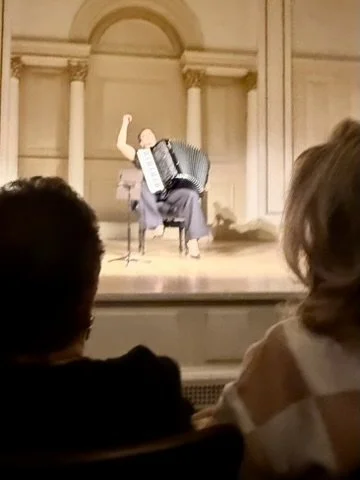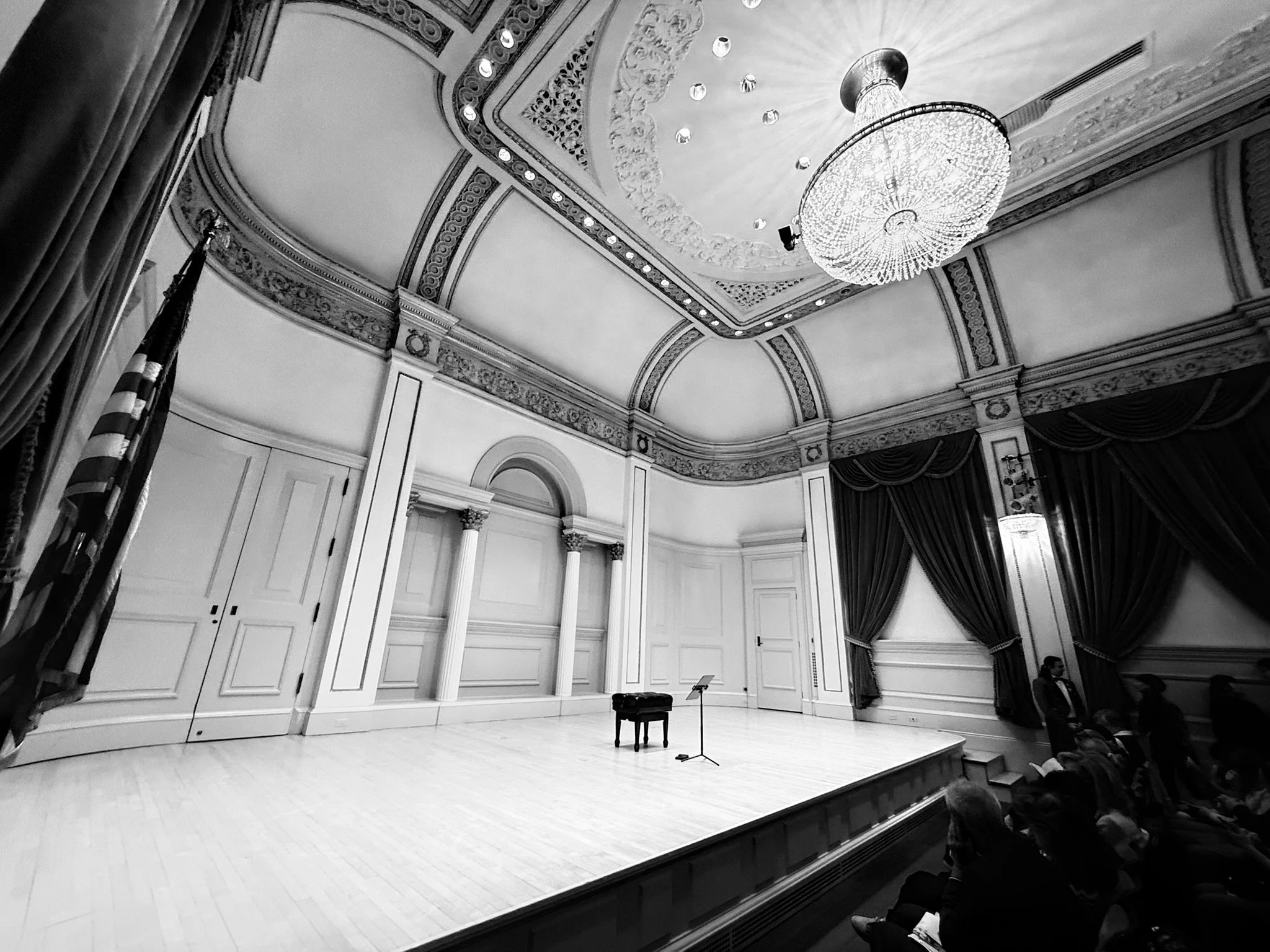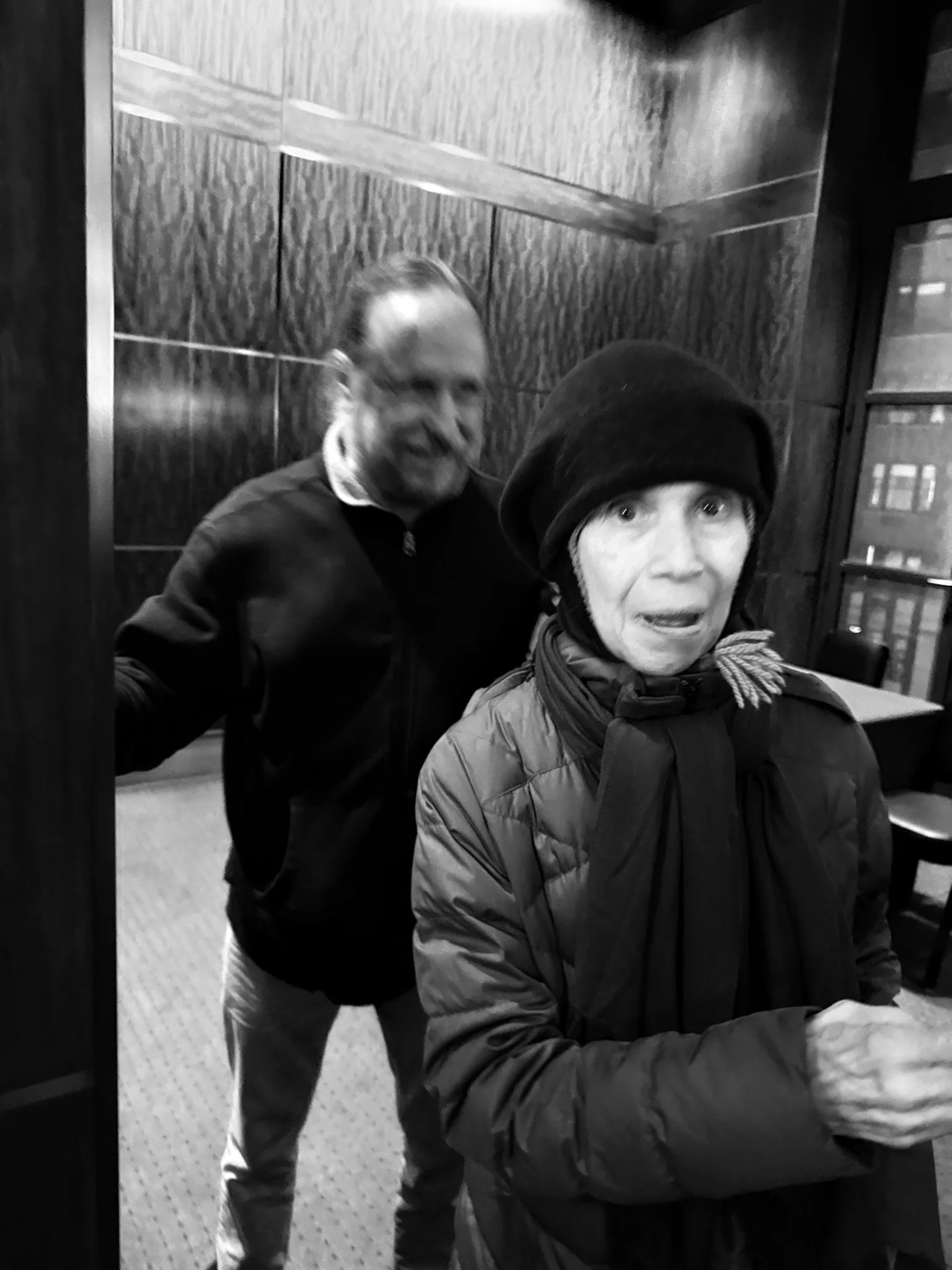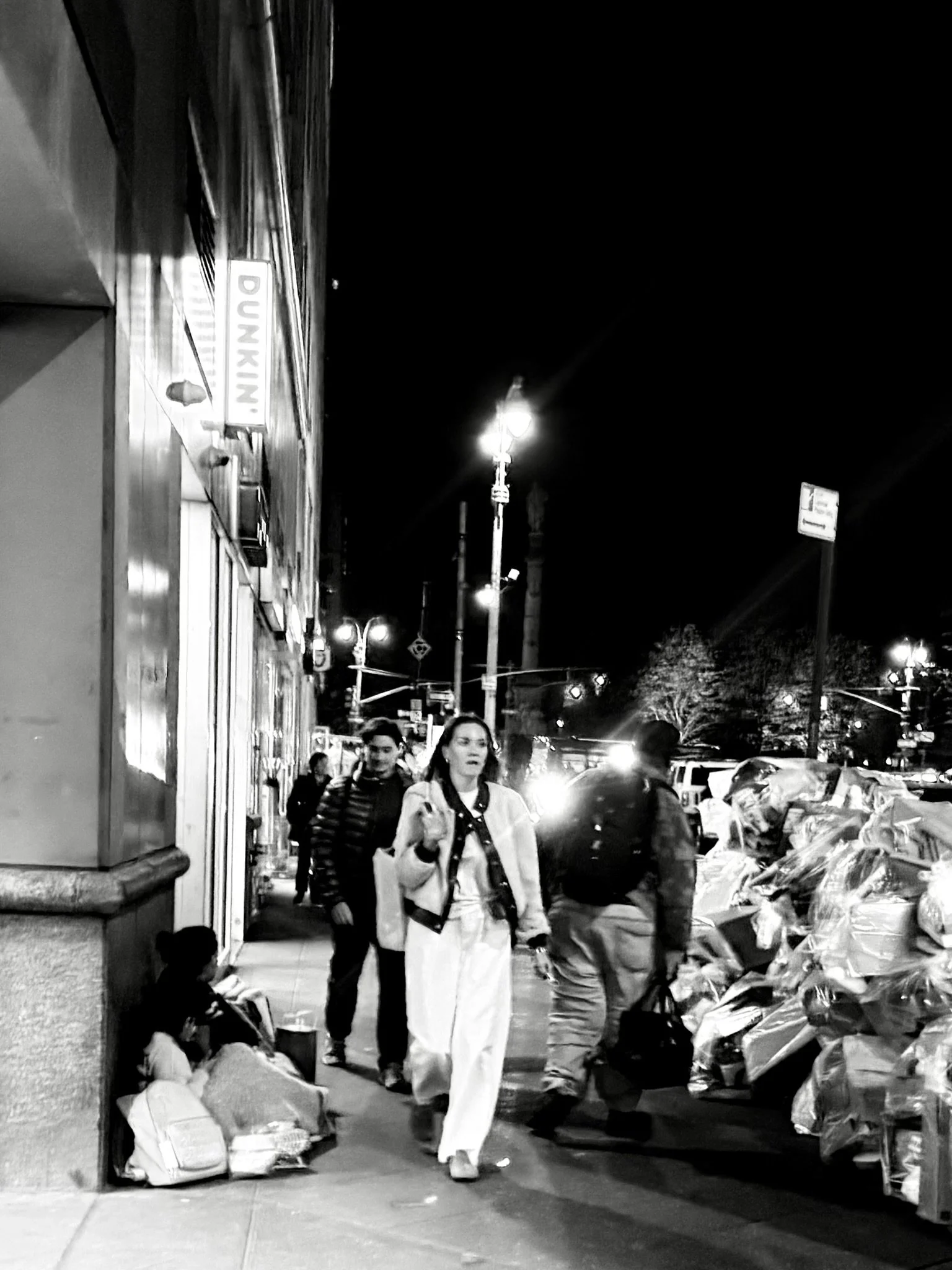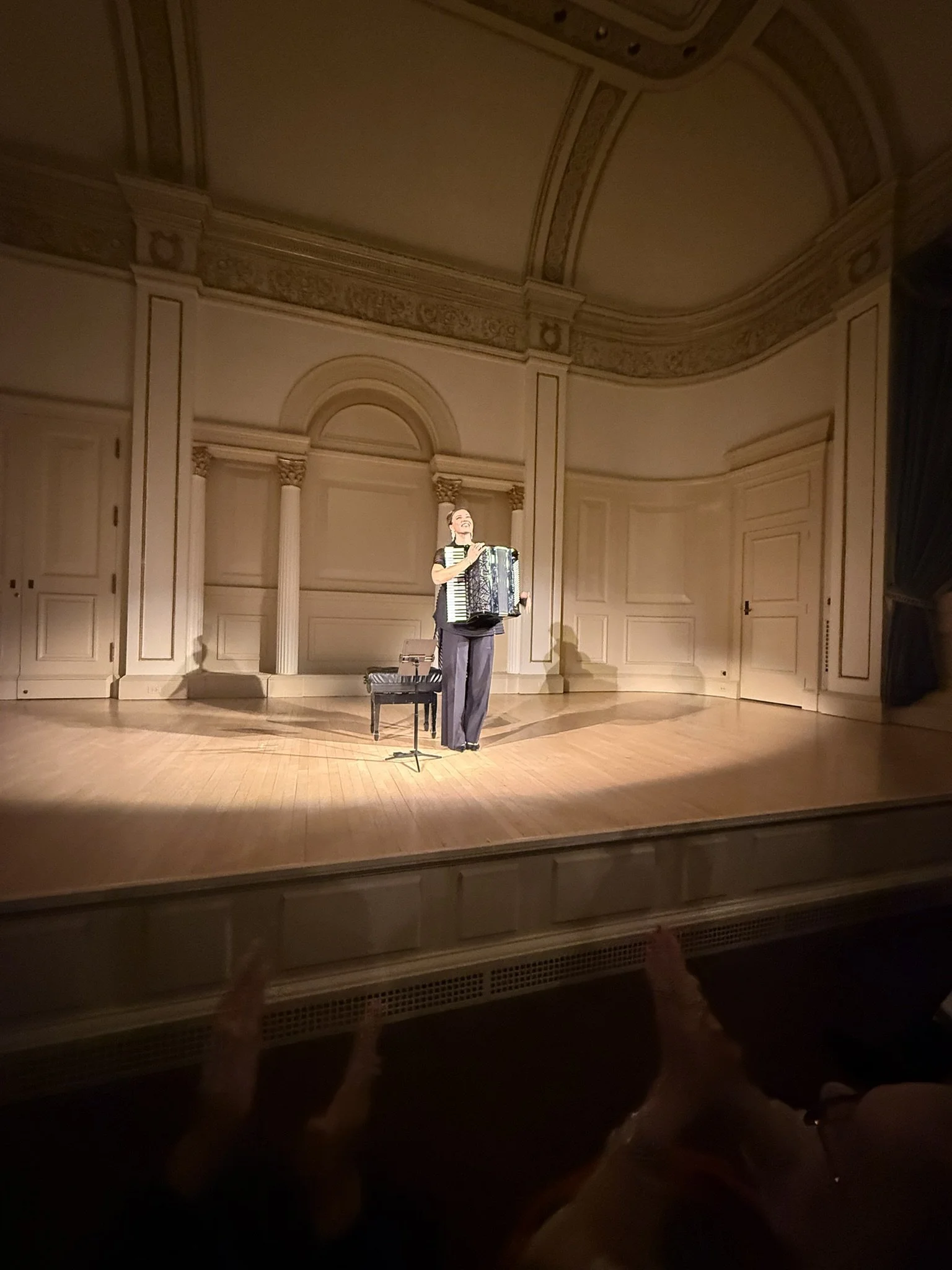Performers
Ksenija Sidorova, Accordion
PHILIP GLASS Opening from Glassworks (arr. Ksenija Sidorova)
J. S. BACH Adagio from Keyboard Concerto in D Minor, BWV 974 (arr. Ksenija Sidorova)
SERGEY AKHUNOV Sketch III
J. S. BACH Chorale Prelude on "Ich ruf’ zu dir, Herr Jesu Christ" (arr. Ksenija Sidorova)
GABRIELA MONTERO Beyond Bach (arr. George Morton and Ksenija Sidorova)
FAZIL SAY Three Ballads (arr. Ksenija Sidorova)
ALBÉNIZ Asturias, leyenda from Suite española
PIAZZOLLA Chau Paris (arr. Ksenija Sidorova)
FRANCK ANGELIS Fantasie on a Theme of Piazzolla, "Chiquilín de Bachín"
SERGEI VOITENKO Revelation
ALEXEY ARKHIPOVSKY Cinderella (arr. Alexander Poeluev)
SCHNITTKE Revis Fairy Tale, Four Movements from Gogol Suite (arr. Friedrich Lips and Ksenija Sidorova)
Ksenia Sidorova gave her debut recital at Carnegie Hall's Weill Recital Hall on 11.5.2025. Almost the entire program was arranged by Ksenia and friends, overflowing with respect for the works, musicians, and friends. As a result, the pieces were deeply connected, and Sidorova's world transcended time and style, unfolding through the accordion.
The program encompassed a wide range of genres, from American minimalism to Bach and numerous folk pieces, imitating a variety of instruments and voices, including organ, folk instruments, orchestra, and voice. The final piece was Schnittke's polystylism, the opera of satire and humor.
This was my first time experiencing an accordion solo in a concert. Ksenia exudes the unique aura of the great performers I've experienced. It reminds me of Jansons' Shostakovich, Mutter's violin, and the precision of Trifonov.
The lights dimmed, and the performance began with a piece written in the 1980s by the renowned American minimalist Philip Glass, who introduced his work. The light reflected off the wall shimmered softly, and when I opened my eyes, I saw an accordion playing, almost like an orchestra peering down from above.
The following arrangement of a Bach concerto offered a clear sound, almost like a human singing voice or a glass harp, supported by a rippling ostinato. The way each hand gripped the keys of the accordion was clearly visible, giving a clear understanding of Bach's instrument's structure. The instrument has many valves, and I felt that understanding their structure further enhanced the enjoyment of listening. Ksenia slowly adjusted the width of the bellows, allowing Bach's music to fill the venue.
Sergei Akhunov's Sketches III was a hybrid of Glass and Bach. Characterized by arpeggio development, it evoked the minimalist regularity of Glass and the beauty of Bach, while also possessing a unique sound. These three pieces were played consecutively, creating the impression of a cohesive piece spanning three movements.
The following Bach piece, BWV 639, allowed the music to breathe freely, with a dynamic range more flexible than that of the organ. Ksenia spoke through the notes. It was an experience that went beyond the organ. Bach's music was breathing, as if I were inside the organ. With each breath drawn through the bellows and the buzzing of the reeds, it was as if I were experiencing Bach within the space of the organ. What I was listening to was not an accordion, but something beyond the organ.
Pigini's four-octave accordion created an organ-like resonance. Occasionally, deep bass tones reminiscent of a contrabassoon evoked the feeling of listening to a large cathedral. Montero's improvisation, Beyond Bach, was born out of a deep respect for Bach, as the structures and melodies of Bach created new sounds and developments that emerged from his free interpretation. This resulted in a musical experience that transcended the boundaries between past and present, composition and performance.
In three ballads by pianist Fazil Say, the accordion spoke and sang as it spun its melodies. In a work dedicated to the poet Nazım, the Turkish composer skillfully depicted contrasts between light and dark, as well as between low and high notes. In Kumru (Dove), music conveys love, peace, hope, and affection as it quietly flies across the sky. Meanwhile, in Sevenlers, he addresses loved ones, expressing elation, conflict, and farewell.
ISAAC ALBÉNIZ's Asturias, Leyenda (from Suite española) evokes the raw energy of northern Spain's coastal region rather than flamenco guitar or Andalusia. "Asturias is a mountain," Ksenia once said. The accordion's bellows were finely tuned, rapidly opening and closing in contrast to the long strokes of the previous piece. The guitar's flutter, relentlessly punctuated like an orchestral tremolo, was as powerful as waves crashing against a cliff.
Piazzolla's bandoneon work epitomized cosmopolitan tango, and Ksenia's playing was truly characteristic. The bellows vibrated, weaving together sounds without long strokes. Piazzolla's unique style was so captivating that Nadia Boulanger once remarked, "Your music is tango." It's as if Dohnányi urged Bartók, who was studying in Vienna, to "write Hungarian music," and his teacher's words gave the expression back its strength. This is music tinged with the sourness of life, different from the Piazzolla I had imagined in my twenties. The emotion of an adult turning his back on the glamorous city and walking forward, carrying the bittersweet memories of a night, seeps through the gaps in the music. Ksenia depicts the floating world with the accordion, similar to Pollini's Chopin.
And then there's Bachin' Boy, dedicated to Ksenia by Frank Angelis. This piece was the highlight. Ksenia, the performer and musician, and why she ended up on the Carnegie stage? Everything was condensed into this piece. The heartbeat of the accordion. Her facial expressions and the sound of the accordion. It was as if violinist Mutter were playing Penderecki, or Rostropovich playing Shostakovich. This piece was pure sadness. A darkness that shattered all hope.
Her performance became even more fulfilling with Slavic Piazzolla, Sergei Voitenko's Revelation, which evokes the structure of Bach, the minimal regularity of Glass, and the emotional impact of Piazzolla. Using the bayan, the piece weaves long, sweeping melodic lines, ornate ornamentation, and a restrained, often trembling accompaniment. A starry, delicate revelation is woven.
Aleksei Arkhipovsky's Cinderella for balalaika tells the story of a melancholic maid growing into a princess. Cinderella's personality, experiences, inner changes, and emotions are expressed in every movement of Ksenia's fingers as she presses the keys and plays the melody, resonating like a breath of life.
Finally, Schnittke's polystylism. Based on Gogol's story, Tchitchikov's Childhood, the narrative depicts growth and ambition, as well as the hopes and anxieties that lurk at the beginning of life. "Bureaucrats" featured a procession of bureaucrats running around, carrying various items. It was Gogol's social satire, mixing humor and instability reminiscent of Shostakovich's The Nose and Lady Macbeth. "Ball" was a twisted waltz, and "Overcoat" vividly depicted humor and pathos, blending comedy and unease—truly opera.
There were two encores. I cannot remember the first one. The second was a Sibelius etude.
The concert featured a diverse range of attendees, including classical music enthusiasts and performers, as well as accordion enthusiasts—the kind often seen at operas and other concerts.
This is the article from her review
I ask if she sees her role as an ambassador, advocating for the accordion in contemporary music. “Absolutely. My teachers started this journey; they were the true pioneers. It’s a big task, so I continue doing that, and of course, there are a lot of colleagues of mine nowadays. The calling is there, and they’re doing the same thing. So I think we’re all raising awareness.” Her advice to prospective accordionists is simple: “Be open to everything. This is your time, you’ve got the time, don’t waste it. Enjoy it!”
クセーニャ シドロワがカーネギーホールのワイルリサイタルホールでデビューリサイタルを行った。プログラムのほぼ全てはクセーニャと友人によるアレンジで、作品と音楽家や友人への敬意で満ち溢れていた。そのため、曲同士の結びつきも強く、一台のアコーディオンが時代と様式を超えたシドロワの世界を展開した。
その内容はアメリカのミニマルからバッハ、さらに数々の民族音楽まで多彩に網羅され、オルガンや民族楽器、オーケストラ、声など、さまざまな楽器や声を模倣する。最後はシュニトケのポリスタイリズム。風刺とユーモアのオペラだ。
カーネギーに25年通っていて、アコーディオンのソロを初めて体験した。クセーニャは私が体験してきた偉大な演奏家が持つ独特のオーラをまとっている。それはヤンソンスのショスタコービチやムターのバイオリンや、トリフォノフの精緻さを思い出させる。
時間になると照明が落ち、アメリカを代表するミニマリスト、フィリップ・グラスが1980年代に自作を紹介するために書いた作品から演奏を始めた。壁に反射する光がぼんやり揺れ、目を開けるとアコーディオンがまるでオーケストラを上からのぞくように奏でている。
グラス作品では、右手と左手が別々に規則的なコードを繰り返し、無数のスペクトラムを描き出す。グラスの様式に忠実で、聴く者を独特の時間の流れに引き込む。私はグラスの作品を何度か聴いたことがあり、「浜辺のアインシュタイン」などを思い出した。
続くバッハの協奏曲のアレンジは、まるで人が歌っているような、または、グラスハープのように澄んだ響きが広がり、さざ波のようなオスティナートが支える。アコーディオンの両手のキーを掴む様子がよく見え、バッハの構造が手に取るように理解できる。楽器には多くの弁が付いており、その構造を知ることで演奏の楽しさがさらに増すと感じた。クセーニャは蛇腹の横幅をゆっくりと調整し、バッハの音楽をカーネギーホールの空間に染み込ませていくようだった。
セルゲイ・アクノフの「スケッチ III」は、グラスとバッハのハイブリット。アルペジオの展開が特徴で、先に聴いたグラスのミニマルな規則性やバッハの美しさを思わせつつ独自の響きを持つ。この3曲は続けて演奏されて、1-3楽章のまとまった曲のようだった。
続くバッハの「BWV 639」では、オルガンより柔軟なダイナミックレンジで音楽を自由に呼吸させていた。クセーニャが音符で語る。これはオルガンを超えた体験だった。まるでオルガンの中にいるかのように、バッハの音楽が息をしている。蛇腹から息を吸い込み、リードがブーっと鳴るたびに、オルガンの空間の中でバッハを体験しているようだった。聴いているのはアコーディオンではなく、オルガンを超えた何かであった。
Piginiのアコーディオンは4オクターブで、目の前でオルガンのような響きが広がった。時折、コントラファゴットのような重低音が、大きなカテドラルで聴いているようだった。続く、モンテロの即興によって生まれた「Beyond Bach」は、バッハへの深い敬意から紡がれた。即興の中でバッハの構造や旋律を自由に解釈しながら、新しい響きや展開が生まれ、過去と現在、作曲と演奏の境界を越えた音楽を体験した。
ピアニスト、ファジル・サイの3つのバラードでは、アコーディオンが語り、歌うように旋律を紡ぐ。トルコ出身のサイは、詩人ナズムに捧げる作品を通して、明暗のコントラストや低音と高音の対比を巧みに描き出す。Kumru(鳩)では、静かに空を渡る愛や平和、希望、そして愛情が音楽に込められている。一方、Sevenlersでは、愛する者への呼びかけに、高揚や葛藤、別れを語った。
ISAAC ALBÉNIZのAsturias, Leyenda(Suite española)では、フラメンコギターやアンダルシアより、むしろスペイン北部の海岸地方の荒々しい息遣い。クセーニャは「アストリアは山だ」と語っていた。アコーディオンの蛇腹は細かく刻まれ、さきほどまでの長いストロークとは対照的に、開いたり閉じたりを高速で繰り返す。ギターのフラッターは、オーケストラのトレモロのように絶え間なく刻まれ、まるで絶壁に打ち付ける波のような迫力だった。
ピアソラのバンドネオン作品は、コスモポリタンなタンゴそのもので、まさにクセーニャらしい演奏だ。蛇腹は震え、長いストロークは使わずに音を紡ぐ。ピアソラは当時、ナディア・ブーランジェに「あなたの音楽はタンゴだ」と評されたように、ピアソラの世界を独自に表現する。ウィーンで学んでいたバルトークに、ドホナーニが「ハンガリーの音楽を書けと促したような、師の言葉を背にした表現の強さ。20代の頃、私が思っていたピアソラとは違う、人生の酸味を帯びた音楽。華やかな街に背を向け、ほろ苦い夜の記憶を抱えながら歩き出す大人の情感が音の隙間から滲む。クセーニャはアコーディオンで浮世を描く。ポリーニのショパンと一緒だ。
そして、フランク・アンジェリスがクセーニャに奉げた「バチンの少年」。この曲がこのプログラムの山だった。クセーニャの演奏家、音楽家、なぜカーネギーのステージを踏むに至ったのか。すべてはこの曲に凝縮されていた。アコーディオンの鼓動。彼女の表情とアコーディオンの音。バイオリニスト、ムターがペンデレツキを、ロストロポービチがショスタコービチを演奏しているようだった。この曲はひたすら悲しかった。希望を閉ざされた闇だった。
ここから、彼女の演奏はさらに充実していった。スラブのピアソラ、セルゲイ・ヴォイテンコの「啓示」は、バッハの構造、グラスのミニマルな規則性、ピアソラの情感のいずれも感じさせる。バヤンを用い、長く弧を描く旋律線や華麗な装飾、そして控えめでしばしば震える伴奏。スタルジックで繊細な啓示が紡がれる。
アレクセイ・アルヒポフスキーによるバラライカのための「シンデレラ」は、物憂げな女中が王女へと成長していく物語。シンデレラの性格や経験、内面の変化や心情が、クセーニャの指の一つ一つ、キーをおさえメロディーを奏でる動作そのものが呼吸であり、命のように響く。
最後はシュニトケのポリスタイリズム。ゴーゴリの物語から「Tchitchikov’s Childhood(チチコフの幼少期)」成長や野心が描かれ、人生の始まりに潜む希望と不安。「Bureaucrats(官僚たち)」は、類を抱えて走り回る官僚の行列。ショスタコーヴィチの鼻やマクベス夫人思わせるユーモアと不安定さが混ざったゴーゴリの社会風刺。「Ball(舞踏会)」では歪んだワルツが、そして「Overcoat(外套)」では滑稽さと悲哀が生き生きと描かれ、喜劇と不穏が入り混じる。まさにオペラ。
アンコールは2曲。最初の曲はわからない。2曲目はシベリウスのエチュード。
このコンサートにはオペラや他の演奏会でも見かけるクラシックの常連や演奏家、アコーディオンを趣味にしている方。さまざまな方々を見受けた。

